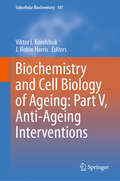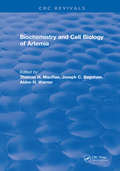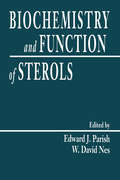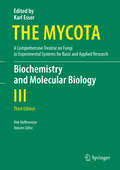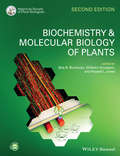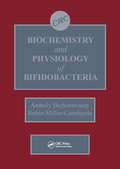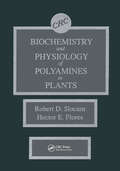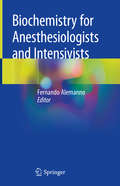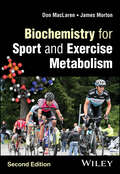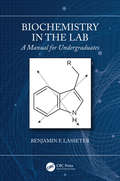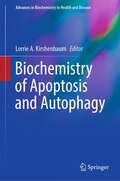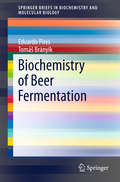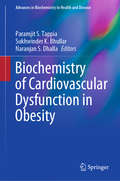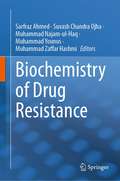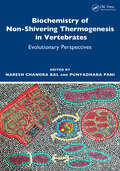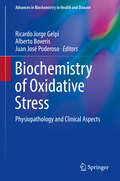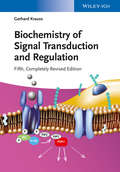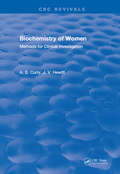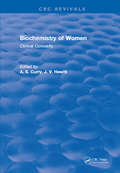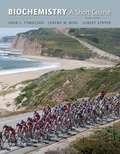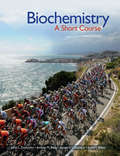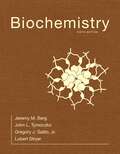- Table View
- List View
Biochemistry and Cell Biology of Ageing: Part V, Anti-Ageing Interventions (Subcellular Biochemistry #107)
by J. Robin Harris Viktor I. KorolchukThis book provides an up-to-date overview of key areas of ageing research with a special focus on anti-ageing intervention strategies, which are currently very much at the forefront of ageing studies.The volume discusses how dietary restriction, supplements or exercise affect the ageing process. Other intervention strategies reviewed are: chaperone activators, telomerase activation, hormetics, senolytics, NAD boosting, geroprotectors, stem cell therapies, resveratrol and melatonin, to just name a few. This book follows on from Parts I-IV of Biochemistry and Cell Biology of Ageing within the Subcellular Biochemistry book series and highlights anti-ageing intervention strategies that were not included in the earlier volumes. Comprehensive and cutting-edge, this book is a valuable resource for experienced researchers and early career scientists alike, who are interested in learning more about the fascinating and challenging question of why and how our cells age.
Biochemistry and Cell Biology of Artemia
by Thomas H. MacRaeThe unusual life history of the brine shrimp, Artemia, and the relative ease with which it can be experimentally manipulated have long made his crustacean a favorite system for biological studies. Over the years, descriptive morphological work has given way to a rigorous analysis of biochemical and cellular aspects of the organism. The underlying theme of the work is often been developmental in nature.This book brings together a wide spectrum of topics under study in the shrimp. Analyses of gene structure and protein synthesis are combined with descriptions of protein interactions characteristic of functional cells.
Biochemistry and Function of Sterols
by Edward J. Parish W. David NesLeading international scientists bring current and developing topics in sterol research together in Biochemistry and Function of Sterols. The authors are experts in each major area of sterol research-medicine, biochemistry, chemistry, and agriculture. Each chapter features the current state of research as well as new and developing research topics. Throughout the volume the focus is on the major and expanding areas of sterol biochemistry and function of sterols in all classes or organisms. The broad scope of this work embraces many disciplines and will be of interest to a variety of researchers, students, and lay people. Professors will find Biochemistry and Function of Sterols an excellent choice as a textbook for courses on steroid, lipid, or plant biochemistry.
Biochemistry and Molecular Biology (The Mycota #III)
by Dirk HoffmeisterThis new edition provides a comprehensive look at themolecular genetics and biochemical basis of fungal biology, covering importantmodel organisms such as Aspergilli while also integrating advances made with zygomycetes and basidiomycetes. This book groups a total of 15 chapters authored by expert scholars in theirrespective fields into four sections. Five chapters cover various aspects ofgene expression regulation. These range from regulation in organismalinteractions between parasitic fungi and their host plant, heavy metal stressand global control of natural product genes to conidiation and regulationthrough RNA interference. Two chapters are dedicated to signal transduction,highlighting MAP-kinase-dependent signaling and heterotrimeric G-proteins. Fungal carbohydrates are the subject of the third section, which addresses bothpolymeric cell wall carbohydrates and trehalose as an important, low molecularweight carbohydrate. The fourth section emphasizes the metabolism of majorelements (carbon, nitrogen, sulfur) and critical cellular pathways for primaryand secondary products.
Biochemistry and Molecular Biology Compendium
by Roger L. LundbladThis book is an accessible resource offering practical information not found in more database-oriented resources. The first chapter lists acronyms with definitions, and a glossary of terms and subjects used in biochemistry, molecular biology, biotechnology, proteomics, genomics, and systems biology. There follows chapters on chemicals employed in biochemistry and molecular biology, complete with properties and structure drawings. Researchers will find this book to be a valuable tool that will save them time, as well as provide essential links to the roots of their science. Key selling features: Contains an extensive list of commonly used acronyms with definitions Offers a highly readable glossary for systems and techniques Provides comprehensive information for the validation of biotechnology assays and manufacturing processes Includes a list of Log P values, water solubility, and molecular weight for selected chemicals Gives a detailed listing of protease inhibitors and cocktails, as well as a list of buffers
Biochemistry and Molecular Biology of Plants
by Russell L. Jones Bob B. Buchanan Wilhelm Gruissem"Biochemistry & Molecular Biology of Plants" is a major contribution to the plant sciences literature, superbly edited by three distinguished scientists, Bob B. Buchanan, Wilhelm Gruissem, and Russell L. Jones, with contributions from more than 50 world-renowned scientists. With over 1,400 pages, 1,100 full-colour original drawings and 500 photographs this work qualifies, in the words of the Science reviewer, as: ""an essential reference for practicing plant biologists and for the increasing number of scientists from other disciplines who are entering the field of plant biology. To exploit fully the wealth of new information provided by the genome projects and to integrate the metabolic, regulatory, and signal transduction pathways of complex organisms, biologists will require a solid command of biochemistry and physiology. For this reason, the publication of Biochemistry Molecular Biology of Plants could not have come at a more opportune and auspicious time. " " This book is meticulously organised and richly illustrated, useful both for teaching and for reference. The multi-authored work provides a contemporary view of its subject, including molecular biology, cell biology, and plant physiology, integrated around the themes of: * compartmentation * cell reproduction * energetics * metabolism * development Read the words of the reviewer in CELL: ""The great strength of this book is that it has integrated its three major components (molecular biology, cell biology, and plant biochemistry) in each of the 24 chapters, resulting in a comprehensive analysis of a multitude of specific topics. " " Who should buy this spectacular text? * Plant biologists and scientists in related fields * Professors in departments of plant biology, plant biochemistry, plant physiology, and related fields * Graduate and upper-level undergraduate students of plant biology * Researchers in the pharmaceutical, biotechnology, and agribusiness industries Images are available directly from the ASPB web site at http: //www. aspb. org/publications/biotext/
Biochemistry and Physiology of Bifidobacteria
by Anatoly BezkorovainyThis book provides a comprehensive reference work on this ubiquitous group of microorganisms for the biomedical community, and intends to stimulate further research into the biochemistry and physiology of bifidobacteria and their role in health and disease of newborns and even adult human beings. Discussions of bifidobacteria include chapters on nomenclature and taxonomy, ecology, morphology, metabolism, membrane and cell wall structure, clinical applications, metal transport, and future research trends. Each chapter ends with a summary. The book is amply illustrated and extensively referenced.
Biochemistry and Physiology of Polyamines in Plants
by Robert D. Slocum Hector E. FloresBiochemistry and Physiology of Polyamines in Plants provides a comprehensive introduction to commonly used methods in polyamine research and the problems unique to plant studies. Topics discussed include polyamine metabolism in plants, the functions of polyamines in plant growth and development, and an examination of analytical methods for polyamines and enzymes of polyamine metabolism. Agronomists, plant physiologists, and biochemists interested in polyamines in plants will find this book to be a valuable reference resource.
Biochemistry for Anesthesiologists and Intensivists
by Fernando AlemannoThis book discusses and explains the importance of biochemistry knowledge in understanding what happens to patients during anesthesia and/or to those being in intensive care. It covers a wide range of topics, such as Cerebral Edema, Shock, Blood-Brain Barrier, The Pulmonary surfactant, The Acid – Base equilibrium, Local anaesthetics, Perineural adjuvants, Normobaric Oxygen Therapy, Theories of Narcosis. Hyperventilation effects and consequences are also presented. For instance, by hyperventilating a patient with a PaCO2 significantly below 25 mmHg, we risk blocking pyruvic acid carboxylation and transforming it into oxalacetic acid, which in turn knocks out the Krebs cycle, possibly leading to a complication, i.e. to metabolic acidosis and not to compensation for respiratory alkalosis. It is also worth remembering that vitamins are actually molecules of pretty considerable potency and should not be simply intended as integrators. If we inject a patient under intensive care with vitamin C, this not only plays a capillary-protective role but facilitates the conversion of dopamine to noradrenaline. As far as vitamin B6 goes, not only is it the most natural of antiemetics but the coenzyme responsible for transforming glutamate as one of the most powerful excitatory mediators into GABA, one of the fiercest inhibitors. Anesthesiological and intensive care practice require a detailed biochemistry knowledge to avoid onset of complications and/or to deal with unexpected events promptly and appropriately. The book is intended for anesthesiologists, intensivists, anesthesia teachers, anesthesia trainees and residents.
Biochemistry for Sport and Exercise Metabolism
by James Morton Donald MacLarenAll-new edition of an introductory textbook on sport and exercise biochemistry and muscle metabolism Biochemistry for Sport and Exercise Metabolism initially examines the essence of the biochemistry of the macronutrients before exploring how exercise mode, intensity, and duration, training status, and nutritional status affects the regulation of energy producing pathways, enabling readers to apply this understanding to develop training and nutrition programs that maximize athletic performance. This textbook includes an overview of energy metabolism, skeletal muscle structure and function and related biochemical concepts, carbohydrates, lipids, and proteins, metabolism, regulation of metabolism, and factors that can influence metabolism, and fatigue. This revised and updated second edition reflects some of the latest advances in the field, with new content on metabolic regulation as well as adaptations to high intensity and strength exercise, endurance exercise, and intermittent exercise. Furthermore, there is a new chapter on biochemical techniques to provide some pertinent background on how reported metabolic changes during exercise are achieved. This textbook features learning objectives, keywords, and key points in each chapter to aid in reader comprehension and reinforce information retention. Written by two highly qualified authors, Biochemistry for Sport and Exercise Metabolism discusses sample topics including: How the energy supply for muscle contraction is achieved from carbohydrates, lipids and protein Muscle contraction, covering propagation of the action potential, excitation-contraction coupling, and the sliding filament mechanismRegulation of the energy systems providing energy for exerciseTechniques for exercise metabolism, including respiratory analysis, ergometry, blood sampling, metabolomics, a-v differences, muscle biopsy, and isotopesExploration of the metabolic events occurring during high intensity, endurance, and high-intensity intermittent forms of exercise Clearly written and completely comprehensive, the second edition of Biochemistry for Sport and Exercise Metabolism continues to be an invaluable learning resource for students across a wide range of sport-related courses.
Biochemistry for Sport and Exercise Metabolism
by James Morton Donald MaclarenHow do our muscles produce energy for exercise and what are the underlying biochemical principles involved? These are questions that students need to be able to answer when studying for a number of sport related degrees. This can prove to be a difficult task for those with a relatively limited scientific background. Biochemistry for Sport and Exercise Metabolism addresses this problem by placing the primary emphasis on sport, and describing the relevant biochemistry within this context.The book opens with some basic information on the subject, including an overview of energy metabolism, some key aspects of skeletal muscle structure and function, and some simple biochemical concepts. It continues by looking at the three macromolecules which provide energy and structure to skeletal muscle - carbohydrates, lipids, and protein. The last section moves beyond biochemistry to examine key aspects of metabolism - the regulation of energy production and storage. Beginning with a chapter on basic principles of regulation of metabolism it continues by exploring how metabolism is influenced during high-intensity, prolonged, and intermittent exercise by intensity, duration, and nutrition.Key Features:A clearly written, well presented introduction to the biochemistry of muscle metabolism.Focuses on sport to describe the relevant biochemistry within this context.In full colour throughout, it includes numerous illustrations, together with learning objectives and key points to reinforce learning.Biochemistry for Sport and Exercise Metabolism will prove invaluable to students across a range of sport-related courses, who need to get to grips with how exercise mode, intensity, duration, training status and nutritional status can all affect the regulation of energy producing pathways and, more important, apply this understanding to develop training and nutrition programmes to maximise athletic performance.
Biochemistry in the Lab: A Manual for Undergraduates
by Benjamin LasseterMost lab manuals assume a high level of knowledge among biochemistry students, as well as a large amount of experience combining knowledge from separate scientific disciplines. Biochemistry in the Lab: A Manual for Undergraduates expects little more than basic chemistry. It explains procedures clearly, as well as giving a clear explanation of the theoretical reason for those steps. Key Features: Presents a comprehensive approach to modern biochemistry laboratory teaching, together with a complete experimental experience Includes chemical biology as its foundation, teaching readers experimental methods specific to the field Provides instructor experiments that are easy to prepare and execute, at comparatively low cost Supersedes existing, older texts with information that is adjusted to modern experimental biochemistry Is written by an expert in the field This textbook presents a foundational approach to modern biochemistry laboratory teaching together with a complete experimental experience, from protein purification and characterization to advanced analytical techniques. It has modules to help instructors present the techniques used in a time critical manner, as well as several modules to study protein chemistry, including gel techniques, enzymology, crystal growth, unfolding studies, and fluorescence. It proceeds from the simplest and most important techniques to the most difficult and specialized ones. It offers instructors experiments that are easy to prepare and execute, at comparatively low cost.
Biochemistry of Apoptosis and Autophagy (Advances in Biochemistry in Health and Disease #18)
by Lorrie A. KirshenbaumOne of the most intriguing and compelling issues to impact contemporary biology to date is the concept that cell death is genetically regulated. Observations by Kerr and Wyllie, made more than 30 years ago on the basis of distinct morphological criteria, markedly distinguished apoptosis from classical cell death by necrosis. Apoptosis is a highly regulated, evolutionary conserved, genetic program of cell death essential for normal development and tissue homeostasis. The discovery of apoptosis as a regulated event and potentially amenable to therapeutic interventions has generated considerable excitement because it meant that disease entities resulting from either too much, or too little, apoptosis could be potentially cured with new therapies that target apoptosis.While there is little doubt that necrosis induced by massive cellular trauma is likely an unregulated event, several lines of investigation have challenged the dogma that necrotic cell death is merely unregulated. Emerging data has shifted the paradigm in our thinking about necrosis as a regulated event.Autophagy is another cellular process that has received considerable attention over the past two decades and its remarkable involvement in the processes of cell survival, death and tumorigenesis. Macro autophagy is a catabolic process that involves the selective and targeted removal of oxidized proteins, macromolecular structures and organelles through an elaborate cellular process involving a lysosome mediated pathway. Other forms of autophagy involving adapter proteins, commonly referred to as chaperone mediated autophagy, involves the selective removal of cellular cargo by the ubiquitin-proteasome pathway.The book will serve as a reference guide for basic and clinical scientists who are interested in understanding how these critical cellular processes impact the pathogenesis of human disease.
Biochemistry of Beer Fermentation (SpringerBriefs in Biochemistry and Molecular Biology)
by Eduardo Pires Tomáš BrányikBeer is the most popular alcoholic beverage in the world. Yet, behind each glass of beer there is an enormous amount of work invested. If the first image that comes to your mind is the lifting of heavy bags of malt or carrying kegs, guess again! Most of the work involved in brewing is carried out by "microworkers" - yeast and their enzymes! These special helpers are responsible for catalyzing the vast majority of the biochemical reactions occurring in all steps that gradually transform the sugary wort into beer. This book not only provides readers with an overview of the whole biochemical process involved in beer fermentation, but also reviews the latest findings in this delightful field, making it essential reading for both scientists and brewing enthusiasts
Biochemistry of Cardiovascular Dysfunction in Obesity (Advances in Biochemistry in Health and Disease #20)
by Naranjan S. Dhalla Paramjit S. Tappia Sukhwinder K. BhullarObesity is an independent risk factor for cardiovascular disease (CVD) in adults as well as in obese children. This book will provide a description of the impact of obesity on the cardiovascular system and increased predisposition to CVD. It will identify the major biochemical mechanisms that lead to the occurrence of myocardial abnormalities and vascular alterations in obesity. We will also have some discussion on the biochemistry of the so-called obesity paradox in relation to CVD. The contributors to this book are international experts on obesity and associated cardiovascular complications. This book is also uniquely positioned as it focuses on the biochemistry of obesity-induced cardiovascular dysfunction. There are 20 chapters in 2 different parts in this book, comprising of Part A: Pathophysiology of Cardiovascular Complications in Obesity (11 chapters) and Part B: Modification of Cardiovascular Dysfunction in obesity (9 chapters). The intent of this volume is to provide current and basic understanding of the biochemical mechanisms of obesity induced cardiovascular dysfunction that will be of value not only to cardiologists and other allied health professionals, but will also stimulate and motivate biomedical researchers and scientists to find the way to prevent the epidemic of obesity associated cardiovascular abnormalities. Furthermore, this book will serve as a highly useful resource for medical students, fellows, residents and graduate students with an interest in the cardiovascular system.In summary, this book covers a broad range of biochemical mechanisms of obesity-induced cardiovascular complications. We hope that the reader will understand that obesity is linked to an increase in the risk and occurrence of fatal CVD. Furthermore, the underlying message presented in the book is that the cause of obesity related disorders is complex and that understanding the biochemistry of cardiovascular dysfunction may contribute to the development of novel interventions for the prevention and treatment of obesity associated comorbidities.
Biochemistry of Drug Resistance
by Muhammad Zaffar Hashmi Sarfraz Ahmed Suvash Chandra Ojha Muhammad Najam-ul-Haq Muhammad YounusThis book provides a comprehensive discussion on the current information and evidence on the latest developments in the field of drugs resistance. Drug resistance is the reduction in effectiveness of a medication such as an antimicrobial or an antineoplastic in treating a disease or condition. This leads to negative outcomes at great risk of public health; therefore, increasing efforts are dedicated to the development of a new generation of medications that will help deal with this phenomenon. Decades of technological innovations in drug design have demonstrated the potential of resistance. Enormous information on various aspects of antibiotics resistance is available. However, literature on drug resistance specifically related to infectious and non-infectious diseases is rarely presented, particularly those focusing on the mechanisms, biochemistry, kinetics, dynamics, and management of drug resistance. Therefore, there is an immense need for a systematic compilation on the available information about this issue. All the chapters are logically selected and arranged to provide state-of-the-art information about all aspects of drugs resistance. After an introductory chapter, four chapters are dedicated to infectious microbial diseases, whereas two other chapters are complimenting this theme and focusing on drugs resistance in ear, nose and throat, and skin diseases. The recent advances in the understanding of drugs resistance in lung, neurological, kidney, heart, and liver diseases are also covered. Biochemistry of drugs resistance in cancer, HIV, ocular, reproductive, and diabetes diseases is also discussed. Finally, a chapter dedicated to the “management of drug resistance” has been included.
Biochemistry of Non-Shivering Thermogenesis in Vertebrates: Evolutionary Perspectives
by Naresh Chandra Bal Punyadhara PaniThis comprehensive reference book covers non-shivering thermogenesis, metabolic rates, and associated diseases. It emphasizes the phylogenetic relations of vertebrate non-shivering thermogenesis (NST) and its evolutionary significance. The book describes how the incidence of metabolic syndromes has reached epidemic levels worldwide due to dysregulation in energy balance. Chapters include the evolution and regulatory mechanisms of NSTs. It covers the role of NST in birds and wild animals, and muscle adaptation during hibernation. The book is meant for researchers and students of biochemistry, molecular medicine, and physiology. It is also useful to physicians and health care professionals.Key Features: Provides in-depth insights on topics related to metabolic rate regulation and thermogenesis Covers the evolution of tachymetabolism and endothermy among vertebrates Analyzes the evolutionary perspectives of non-shivering thermogenesis in different organisms Discusses the evolution of brown adipose tissue and non-shivering thermogenesis in mammals Provides graphs, flowcharts, and descriptive figures for easy understanding of concepts
Biochemistry of Oxidative Stress: Physiopathology and Clinical Aspects (Advances in Biochemistry in Health and Disease #16)
by Ricardo Jorge Gelpi Alberto Boveris Juan José PoderosoThe strongest point of this book titled "Biochemistry of Oxidative Stress: Physiopathology and Clinical Aspects", is that the academic and scientific background of the authors/editors guarantee the authorship of a book comprising all aspects of oxidative stress, ranging from very molecular aspects, to clinical application, including the antioxidant therapy. Of particular importance is the fact that the aforementioned aspects are described in the book in a general section and in three different and important pathologies, such as cardiovascular diseases, neurodegenerative diseases, and cancer. The importance of these pathologies lays in the fact that, taken separately or together, they represent by far the leading cause of death in the world. Finally, all the chapters have been written by highly recognized authorities in the field of their investigations. At least to our knowledge, this is the first book with this characteristics in the field of oxidative stress.
Biochemistry of Signal Transduction and Regulation
by Gerhard KraussOriginally based on a graduate course taught by the author, this true classic has once again been extensively updated to incorporate key new findings in biological signaling. With over half of the content re-written, plus 70 brand new and 50 revised figures, this is the most up-to-date textbook on signaling available anywhere.Thanks to its clear structure, hundreds of illustrative drawings, as well as chapter introductions and newly added study questions, this text excels as a companion for a course on biological signaling, and equally as an introductory reference to the field for students and researchers. Generations of students and junior researchers have relied on "the Krauss" to find their way through the bewildering complexity of biological signaling pathways.
Biochemistry of Vitamin A
by Jagannath GangulyThe main emphasis of this text is on the biochemistry, metabolism and systemic mode of action of vitamin A. The physiological, biochemical and nutritional aspects of naturally occurring retinoids are clearly addressed. Chapters review biogenesis, absorption, storage, transport, and metabolic transformations of vitamin A. Further discussion includes vision and bacteriorhodopsin, vitamin A deficiency and hypervitaminosis A, and the vitamin A in prevention and cure of cancer.
Biochemistry of Women Methods: For Clinical Investigation
by A.S. CurryThis book is written by experts who, using the latest techniques, describe laboratory investigations into women from conception to the grave. We asked the authors tp pay particular attention to the interpretation of laboratory results so we hope the book will be of interest to clinicians as well as to medical scientists.
Biochemistry of Women: Clinical Concepts
by A.S CurryThis book concerns the clinical chemistry of women � from conception to the grave. It concerns their medical problems and the laboratories� role in elucidating these and in monitoring treatment. The book represents the current �state of the art� and although in many areas there are sometimes widely divergent opinions, it is good that these should be aired so that problem areas can be revealed and opinions revised when further experimental work is done as a consequence.
Biochemistry: A Short Course (Second Edition)
by John L. Tymoczko Jeremy M. Berg Lubert StryerThis book covers the fundamentals of biochemistry and its topics are broadly grouped under three parts : Molecular design of life,Transducing and storing energy and Synthesizing the molecules of life.
Biochemistry: A Short Course (loose-leaf)
by Lubert Stryer John Tymoczko Jeremy Berg Gergory GattoDerived from the classic text originated by Lubert Stryer and continued by John Tymoczko and Jeremy Berg, Biochemistry: A Short Course focuses on the major topics taught in a one-semester biochemistry course. With its brief chapters and relevant examples, this thoroughly updated new edition helps students see the connections between the biochemistry they are studying and their own lives. The focus of the 4th edition has been around: * Integrated Text and Media with the NEW SaplingPlus Paired for the first time with SaplingPlus, the most innovative digital solution for biochemistry students. Media-rich resources have been developed to support students' ability to visualize and understand individual and complex biochemistry concepts. Built-in assessments and interactive tools help students keep on track with reading and become proficient problem solvers with the help and guidance of hints and targeted feedback--ensuring every problem counts as a true learning experience. * Tools and Resources for Active Learning A number of new features are designed to help instructors create a more active environment in the classroom. Tools and resources are provided within the text, SaplingPlus and instructor resources. * Extensive Problem-Solving Tools A variety of end of chapter problems promote understanding of single concept and multi-concept problems. Built-in assessments help students keep on track with reading and become proficient problem solvers with the help and guidance of hints and targeted feedback--ensuring every problem counts as a true learning experience. Unique case studies and new Think/Pair/Share Problems help provide application and relevance, as well as a vehicle for active learning.
